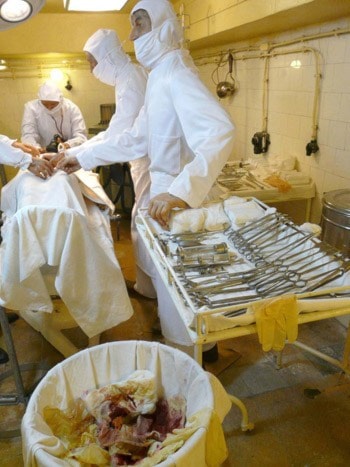BUDAPEST—The temperature is cool in the all-but-empty tunnels of the Hospital in the Rock, making them a pleasant place to be in Budapest’s hot summer. Today’s monastic tranquillity makes it difficult to imagine what a hellhole this would have been in December 1944 and January 1945 during the Siege of Budapest, when these halls were packed with the living and the dying.
“They ran out of food, and medicine, but they still had bandages because they took them off the dead people, sterilized them and used them again,” says Hospital in the Rock guide Attila Vegh. The deceased were carted out of the underground hospital at night and buried in bomb craters. At the same time, dead horses were brought back and cooked in the kitchen.
The hospital had been created in the 1930s, as a second world war loomed, in a section of the cave system that honeycombs the rock under Buda Castle. When Hungary entered the war, on the side of the Nazis, the hospital was designed to hold 60. But over Christmas 1944, with the Russian army advancing on the city, 600 crowded in. There was one toilet for men, one for women.
The Siege of Budapest ended in February 1945 with the Soviets victorious, following months of street-to-street fighting that killed an estimated 40,000 civilians and destroyed 80 per cent of Budapest. After that the Hospital in the Rock was mothballed, except for two months in 1956 when it treated casualties from the year’s uprising against Soviet rule, which was put down with tanks.
But in the 1960s it found new purpose as a nuclear fall-out shelter, and for the next 40 years, until 2002, it was a top-secret facility. Fuel trucks kept its generators running by pretending to water flowerbeds above the complex; its power plant emissions were pumped out of a fake house near the Chain Bridge, a well-known Budapest landmark.
The Hospital in the Rock wasn’t where Hungary’s Communist leaders would have spent a third world war. “There are many other bunkers under Budapest,” says Vegh. This facility was intended to house 200 doctors and nurses for three weeks after a nuclear attack. Then to treat survivors, who would be allowed in from above. In reality, only a caretaker and his wife ever used the place, changing the sheets on the beds every two weeks and keeping the equipment in working order.
On his tour, Vegh shows a room still filled with medicines and anti-radiation kits. There’s also Russian spyware from the 1960s, looking very large and clunky to the modern eye.
Plenty more material left over from the 1960s is scattered around, including crates of gas masks piled by the hospital entrance. These, it turns out, aren’t just for display: they’re the real things and visitors can buy them. In fact, besides “full head gas mask set,” a list of items for sale in the souvenir shop includes “stretcher,” “civil protection uniform” and “medical box–fully equipped.”
They could be the perfect gifts for your “be prepared” friends.
Explore More:
For more information on the Hospital in the Rock visit its website at www.hospitalintherock.com.
For information on travel in Hungary visit the Hungarian National Tourist Office website at www.gotohungary.com.
